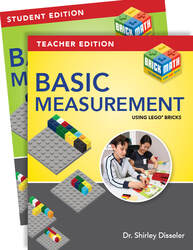 Last month, the Brick Math lesson was about Customary Liquid Measures (cups, pints, quarts, etc.). We got a LOT of comments about how the US should be using metric measures (liters, grams, meters, etc.) like the rest of the world! Well, we can’t control that, but we know that kids need to learn metric measures, too—and luckily, Brick Math also includes lessons on metric measures. So the Brick Math Lesson of the Month for November 2020 is about modeling and converting metric measures and is taken from Basic Measurement Using LEGO® Bricks. To get the November 2020 lesson, and a new lesson each month, sign up here.  The lesson starts with the Teaching Guide. It begins by showing how to model the metric system with bricks, using a 1x3 brick as the base unit (liter, gram, meter) and 1x1 bricks to model the tenfold increases or decreases from the base unit. The model includes the vocabulary you need to talk about the metric system (Kilo, Hecto, Deka, Deci, Centi and Milli). Then, using the model, students learn how to convert from one metric value to another: in this lesson, from the base unit of meters to centimeters (1/100). You can use this method to convert any metric values.  Pages from the Student Workbook are included after the Teacher’s section. Have your student work along with you using these pages to draw their brick models and answer questions about the lesson. It’s important for elementary students to get comfortable with the metric system, even if we here in the US don’t use it in our everyday lives. Students will soon encounter the metric system as they move forward in math, so building a strong foundation (with bricks, of course!) for understanding the metric system is key, typically in grades 2 – 4. Brick Math is a K-6 math curriculum that uses LEGO® bricks to model 11 different math subjects: Counting, Addition, Subtraction, Multiplication, Division, Basic Fractions, Basic Measurement, Fraction Multiplication, Fraction Division, Advanced Measurement and Geometry, and Decimals. It works well for homeschooling, math intervention, enrichment, and as a whole-school program. Materials are simple and are not shared between students. It adapts easily to online instruction. If you teach math or have a student at home who is learning math, check brickmath.com. The website includes videos for both teacher training and direct instruction of students. You can learn more about how Brick Math improves student math test scores and hear what people who are using Brick Math have to say about the program.
0 Comments
Your comment will be posted after it is approved.
Leave a Reply. |
Categories
All
Archives
July 2024
|


